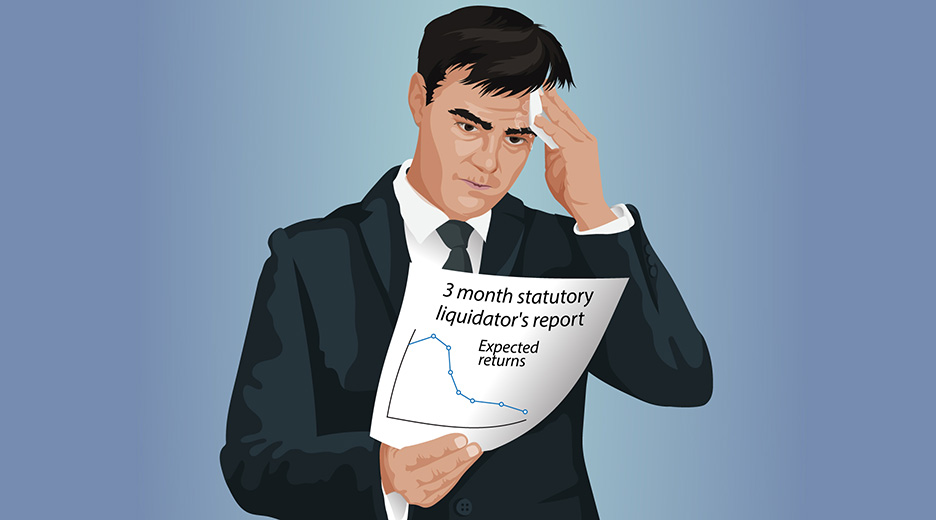Are you an anxious creditor? What the 3 month statutory liquidator’s report will tell you…
Are you owed money by a company that is being wound up? Don’t get your hopes up until you have seen the 3 month statutory liquidator’s report. It is this report that will give a clear indication of the likelihood of a return.

Here we set out the requirements of the 3-month statutory report and explain what it will, and will not, tell you.
What is the statutory report?
Going by the catchy official title of ‘Statutory Report of Liquidator’ or ‘Report about dividends to be given in certain external administrations’, the statutory report is an extensive document that must be submitted to creditors and filed with the Australian Securities and Investments Commission (ASIC) within three months of a company’s winding up being initiated (see rule 70-40 of the Insolvency Practice Rules (Corporations) 2016 (Cth)).
It is the third ‘report’ provided to creditors, following the initial information report (detailing liquidator appointment) and the initial remuneration notice (detailing the liquidator’s proposed fees and expenses for creditor approval).
So what must the report contain? Rule 70-40(3) sets out the statutory requirements. The report must detail:
- The estimated assets and liabilities of the company. This is usually presented through the company’s balance sheet, with notes attached. These notes cover such matters as the likelihood of recovering certain debts and details of any plant and equipment. Often the report will identify any actions that have been taken to realise certain asset classes (such as the sale of real property or plant, or making insurance claims on behalf of the company).
- Inquiries relating to the liquidation that have been undertaken to date. This may include interviews with directors, examinations of the company books and reviews of property and security registers. It may also describe actions related to the ongoing running of the company. The liquidator will also signpost future activities.
- What happened to the business of the company. This usually covers, in broad terms, the causes of the financial distress/insolvency of the company.
- The likelihood of creditors receiving a dividend before the winding up. This is the part that creditors will usually be most interested in. Unfortunately for unsecured creditors, predicted returns are usually cents on the dollar at best (and often zero).
- Possible recovery actions. This covers, for example, any proposed action to pursue creditors for an ‘unfair preference’ claim or investigations of officers (eg. criminal wrongdoing).
The statutory report usually also describes more administrative matters relating to the process of the liquidation, such as the details of any committee of inspection (COI) appointed, details of matters for creditors to vote on or notification about a meeting of creditors.
Is the statutory report helpful to creditors?
On the whole, creditors shouldn’t be too optimistic about the contents of this report. The reports often say little, which is usually a bad indicator for the prospects of creditors getting a financial return. In many cases this is due to the large number of assetless liquidations in Australia. Liquidators will only do the work they are funded to do. No one can force the liquidator to carry out significant work without funding to do so.
On the other hand, if creditors are realistic and see it as a good first step in an orderly analysis of the liquidation then it is very useful for creditors to see the overview it provides. After a three month period it is reasonable to expect a liquidator to get a handle of the situation and be in a position to write a concise report. This report is an improvement on a scenario where no written report is provided to creditors.
Does the statutory report differ in a simplified liquidation?
A simplified liquidation is a new liquidation procedure only available to relatively small companies in Australia (companies that have liabilities of less than $1 million). A simplified liquidation moves quickly, and with fewer formalities, relative to a regular creditors’ voluntary liquidation.
In light of this, the statutory report is more streamlined in a simplified liquidation. Notably, it is also the only reporting required from the liquidator.
Under Rule 70-40(2), this report must detail:
- anything that has been done by the liquidator to date;
- the date on which the winding up is likely to end; and
- the likelihood of creditors receiving a dividend.
What does the statutory report mean for creditors?
As discussed, the statutory report is the best indicator to the creditor whether they can expect to get anything out of the winding up process. Other mechanisms, such as the COI, requesting information or meetings of the liquidator are available, but they are unlikely to change the overall outcome.
From the liquidator’s perspective, this is often an opportunity in assetless administrations to ask for funding from creditors — something that is rarely given. For more information on this topic, check out How Do You Work Out if a Liquidator is Funded?
An anxious creditor should be realistic about what the statutory report will indicate. If a director of the debtor company has engaged in wrongdoing at the expense of creditors, this report can only possibly indicate the start of the process, not the end.
Where action is pursued, it may take many years, including investigations and examinations, before it even gets to substantive litigation.
While the statutory report provides meaningful information to creditors, that information (ie. low to zilch returns) will usually be unwelcome. The liquidator cannot realistically provide assurance to creditors that they will get a financial return and if there is a financial return there would need to be a quick realisation of assets like securities, cryptocurrency or plant and equipment. Otherwise, if any projected returns are based upon litigation, it may take a long time for those monies to be obtained and the amount of the return is subject to high risk.